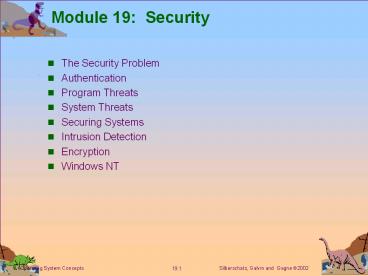Module 19: Security - PowerPoint PPT Presentation
1 / 17
Title:
Module 19: Security
Description:
Module 19: Security The Security Problem Authentication Program Threats System Threats Securing Systems Intrusion Detection Encryption Windows NT – PowerPoint PPT presentation
Number of Views:154
Avg rating:3.0/5.0
Title: Module 19: Security
1
Module 19 Security
- The Security Problem
- Authentication
- Program Threats
- System Threats
- Securing Systems
- Intrusion Detection
- Encryption
- Windows NT
2
The Security Problem
- Security must consider external environment of
the system, and protect it from - unauthorized access.
- malicious modification or destruction
- accidental introduction of inconsistency.
- Easier to protect against accidental than
malicious misuse.
3
Authentication
- User identity most often established through
passwords, can be considered a special case of
either keys or capabilities. - Passwords must be kept secret.
- Frequent change of passwords.
- Use of non-guessable passwords.
- Log all invalid access attempts.
- Passwords may also either be encrypted or allowed
to be used only once.
4
Program Threats
- Trojan Horse
- Code segment that misuses its environment.
- Exploits mechanisms for allowing programs written
by users to be executed by other users. - Trap Door
- Specific user identifier or password that
circumvents normal security procedures. - Could be included in a compiler.
- Stack and Buffer Overflow
- Exploits a bug in a program (overflow either the
stack or memory buffers.)
5
System Threats
- Worms use spawn mechanism standalone program
- Internet worm
- Exploited UNIX networking features (remote
access) and bugs in finger and sendmail programs. - Grappling hook program uploaded main worm
program. - Viruses fragment of code embedded in a
legitimate program. - Mainly effect microcomputer systems.
- Downloading viral programs from public bulletin
boards or exchanging floppy disks containing an
infection. - Safe computing.
- Denial of Service
- Overload the targeted computer preventing it from
doing any sueful work.
6
The Morris Internet Worm
7
Threat Monitoring
- Check for suspicious patterns of activity i.e.,
several incorrect password attempts may signal
password guessing. - Audit log records the time, user, and type of
all accesses to an object useful for recovery
from a violation and developing better security
measures. - Scan the system periodically for security holes
done when the computer is relatively unused.
8
Threat Monitoring (Cont.)
- Check for
- Short or easy-to-guess passwords
- Unauthorized set-uid programs
- Unauthorized programs in system directories
- Unexpected long-running processes
- Improper directory protections
- Improper protections on system data files
- Dangerous entries in the program search path
(Trojan horse) - Changes to system programs monitor checksum
values
9
FireWall
- A firewall is placed between trusted and
untrusted hosts. - The firewall limits network access between these
two security domains.
10
Network Security Through Domain Separation Via
Firewall
11
Intrusion Detection
- Detect attempts to intrude into computer
systems. - Detection methods
- Auditing and logging.
- Tripwire (UNIX software that checks if certain
files and directories have been altered I.e.
password files) - System call monitoring
12
Data Structure Derived From System-Call Sequence
13
Encryption
- Encrypt clear text into cipher text.
- Properties of good encryption technique
- Relatively simple for authorized users to incrypt
and decrypt data. - Encryption scheme depends not on the secrecy of
the algorithm but on a parameter of the algorithm
called the encryption key. - Extremely difficult for an intruder to determine
the encryption key. - Data Encryption Standard substitutes characters
and rearranges their order on the basis of an
encryption key provided to authorized users via a
secure mechanism. Scheme only as secure as the
mechanism.
14
Encryption (Cont.)
- Public-key encryption based on each user having
two keys - public key published key used to encrypt data.
- private key key known only to individual user
used to decrypt data. - Must be an encryption scheme that can be made
public without making it easy to figure out the
decryption scheme. - Efficient algorithm for testing whether or not a
number is prime. - No efficient algorithm is know for finding the
prime factors of a number.
15
Encryption Example - SSL
- SSL Secure Socket Layer
- Cryptographic protocol that limits two computers
to only exchange messages with each other. - Used between web servers and browsers for secure
communication (credit card numbers) - The server is verified with a certificate.
- Communication between each computers uses
symmetric key cryptography.
16
Computer Security Classifications
- U.S. Department of Defense outlines four
divisions of computer security A, B, C, and D. - D Minimal security.
- C Provides discretionary protection through
auditing. Divided into C1 and C2. C1 identifies
cooperating users with the same level of
protection. C2 allows user-level access control. - B All the properties of C, however each object
may have unique sensitivity labels. Divided into
B1, B2, and B3. - A Uses formal design and verification
techniques to ensure security.
17
Windows NT Example
- Configurable security allows policies ranging
from D to C2. - Security is based on user accounts where each
user has a security ID. - Uses a subject model to ensure access security. A
subject tracks and manages permissions for each
program that a user runs. - Each object in Windows NT has a security
attribute defined by a security descriptor. For
example, a file has a security descriptor that
indicates the access permissions for all users.































